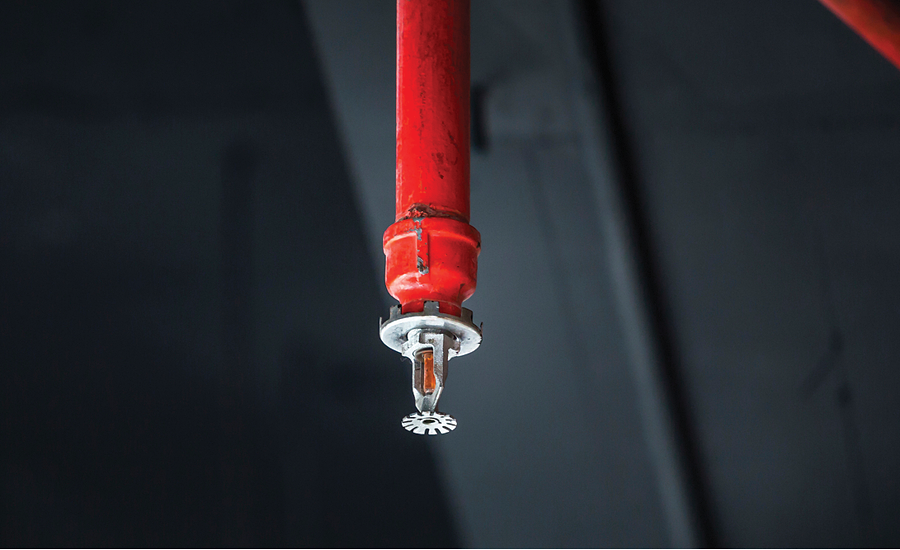When it comes to reducing fire’s potentially devastating impact on people and property, there is simply no equal to fire sprinkler systems. Since the late 19th century, fire sprinkler systems have been utilized and continue to evolve as one of the most reliable fire protection systems available today.
NFPA’s most recent “U.S. Experience with Sprinklers” report shows that between 2007 and 2011 sprinklers operated in 91% of all reported structure fires large enough to activate them. Although this number excludes buildings under construction and buildings without sprinklers in the fire area, when the sprinklers operated, they were effective 96% of the time, resulting in a combined performance of operating effectively in 87% of reported fires where sprinklers were present in the fire area and the fire was large enough to activate them.
This high rate of sprinkler activation success begs the question: What went wrong in the 9% of fires in which sprinklers should have operated but did not? In most cases, some type of human error was to blame. The following are the top five reasons for sprinkler failure and the NFPA standards that work to mitigate these issues:
1. System shutoff
Almost two-thirds (64%) of sprinkler failures occur because the equipment is shut off. This can happen when a building is vacant or under construction or when there are system problems involving leaks or other impairments.
NFPA 25, Standard for the Inspection, Testing and Maintenance of Water-Based Fire Protection Systems, establishes the minimum requirements for the periodic inspection, testing and maintenance of water-based fire protection systems, and addresses each of the leading causes of sprinkler failures. Closure of control valves is addressed in Chapter 13. An impairment program outlined in Chapter 15 minimizes the length of time a system is out of service, and establishes procedures that ensure systems and valves are properly returned to service upon the completion of all inspection, testing and/or maintenance activities.
2. Manual intervention
Manual intervention that defeats a fire sprinkler system accounts for 17% of related failure to operate and represents the second-leading cause of sprinkler failures. Either building staff or firefighters may shut off a system after the fire starts but before sprinklers operated. This may occur when the fire was not immediately visible or was assumed to have been already extinguished. Manual intervention also may occur when some type of obstruction is installed after the sprinkler system has already been installed and the obstruction prevents the fire’s heat from activating the sprinkler system. It also can occur depending on how close the obstruction is to the sprinkler head, where the obstruction can prevent the water from reaching the hazard, or prevent the sprinkler water discharge pattern from developing properly.
Occupancy type, water supply, closure of valves and change in occupancy or commodity classification that render the installed sprinkler system unsuitable are just a few of the considerations that need to be reviewed before firefighting in a sprinklered building. NFPA 13E, Recommended Practice for Fire Department Operations in Properties Protected by Sprinkler and Standpipe Systems, provides guidance for buildings under construction, inspection and pre-incident planning; fire-ground operations; post-fire operations for properties protected by automatic sprinklers; properties protected by exterior sprinklers for protection against exposure fires; and properties protected by standpipe systems.
3. Damaged components
The one mostly nonhuman error for sprinkler system failure is damaged components, which contributes to 7% of sprinkler system failures. Component damage mainly consists of fires where automatic extinguishing equipment was damaged by explosions or by the collapse of a ceiling, roof or entire building. NFPA 13, Standard for the Installation of Sprinkler Systems; NFPA 13D, Standard for the Installation of Sprinkler Systems in One- and Two-Family Dwellings and Manufactured Homes; NFPA 13R, Standard for the Installation of Sprinkler Systems in Low-Rise Residential Occupancies; and NFPA 25 all are written with the assumption the sprinkler system is designed to handle only a single fire at a time. None of these codes accounts for the severity of explosions or the collapse of structural components of the building.
4. Lack of maintenance
Six percent of sprinkler failure is due to a lack of maintenance. NFPA 4, Standard for Integrated Fire Protection and Life Safety System Testing, and NFPA 25 provide minimum requirements to confirm systems, if designed to function together, are operating appropriately and maintain the system to ensure proper function.
NFPA 4 provides testing protocols for new or existing integrated fire protection and life-safety systems where such testing is required. An integrated system test confirms that operation, interaction and coordination of multiple individual systems perform their intended function. Many assume these tests are conducted before a certificate of occupancy is issued. Similarly, if a new system is added or a system is modified to existing integrated systems, there’s sometimes the assumption that testing is being performed, which ensures the “handshake” between the systems has been met. This is not true. However, NFPA 4 provides requirements for members on the integrated testing team, writing test plans, developing test scenarios and frequencies, as well as documenting this information for the owner.
NFPA 25 provides requirements to ensure a reasonable degree of protection for life and property from fire through minimum inspection, testing and maintenance methods for water-based fire protection systems. Known as the “wear and tear” document, NFPA 25 is not intended to evaluate a fire sprinkler system’s design, but rather have the inspector visually inspect the system components.
NFPA 25 categorizes the level of impact for components not meeting the code into three terms: impairment, critical deficiency or noncritical deficiency. Although NFPA 25 does not specify a tagging structure for identifying these levels, many states have developed a series of different color tags to be placed on a system or components to the significance of the condition identified. Impairments include the highest priority problem and should be corrected as soon as possible. Deficiencies are defined as a condition that will or has the potential to adversely impact the performance of a system or portion thereof. Deficiencies should be corrected as soon as practical considering the severity of the risk. Critical deficiencies will still allow the system to perform, but its effectiveness could be impacted. Noncritical deficiencies do not impact system performance but should be corrected in a reasonable time. (Table A.3.3.7, “Water-Based Fire Protection System Inspection and Testing Findings” of the 2014 edition of NFPA25, features a list of examples and the associated deficiency/impairment.)
5. Inappropriate systems for hazard
The fifth reason sprinklers fail to operate is because the system is inappropriate for hazard. Five percent of sprinkler system failures are caused by an improper design of the system, wrong type of agent or the wrong type of system for the agent. One of the most critical decisions in designing a sprinkler system is determining the occupancy classification or commodity type. This decision impacts design and installation considerations, including sprinkler discharge criteria, sprinkler spacing and water supply requirements.
Throughout the life of a building, the use and occupancy type may change. NFPA 1, Fire Code, requires the owner or occupant to evaluate the adequacy of the installed system if there are any changes in occupancy, user, process or materials.
Among all the estimated sprinkler system failures that occurred between 2007 and 2011, only 7% were because of failing equipment (i.e., damaged components). This means if the four other human-error-related causes of sprinkler failures (equipment being shut off, manual intervention defeated the equipment, lack of maintenance, equipment inappropriate for type of fire) could be eliminated, the sprinkler failure rate would drop from the estimated 9% to 0.6%.
Addressing these issues also would improve the effectiveness of the vast majority of sprinklers that do operate.
NFPA standards, such as NFPA 13, NFPA 13D, NFPA 13R, NFPA 25, as well as NFPA 4, each contribute valuable tools that building owners, insurers, homeowners and facility managers can implement to increase sprinkler operation while adequately protecting their facilities and the most important commodity of all – the people inside them.
This article was originally titled “Failure to launch” in the October 2016 print edition of PM Engineer.


